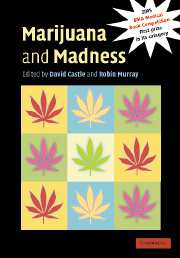Book contents
- Frontmatter
- Contents
- List of contributors
- Foreword
- Preface
- 1 The cannabinoid system: from the point of view of a chemist
- 2 How cannabis works in the brain
- 3 Acute and subacute psychomimetic effects of cannabis in humans
- 4 The association between cannabis use and depression: a review of the evidence
- 5 Cannabis and psychosis proneness
- 6 Is there a specific ‘cannabis psychosis’?
- 7 Cannabis as a potential causal factor in schizophrenia
- 8 Cannabis abuse and the course of schizophrenia
- 9 The endogenous cannabinoid system in schizophrenia
- 10 Cannabinoid ‘model’ psychosis, dopamine–cannabinoid interactions and implications for schizophrenia
- 11 Motives that maintain cannabis use among individuals with psychotic disorders
- 12 Addressing cannabis abuse in people with psychosis
- 13 Residual cognitive effects of long-term cannabis use
- Index
- References
4 - The association between cannabis use and depression: a review of the evidence
Published online by Cambridge University Press: 07 December 2009
- Frontmatter
- Contents
- List of contributors
- Foreword
- Preface
- 1 The cannabinoid system: from the point of view of a chemist
- 2 How cannabis works in the brain
- 3 Acute and subacute psychomimetic effects of cannabis in humans
- 4 The association between cannabis use and depression: a review of the evidence
- 5 Cannabis and psychosis proneness
- 6 Is there a specific ‘cannabis psychosis’?
- 7 Cannabis as a potential causal factor in schizophrenia
- 8 Cannabis abuse and the course of schizophrenia
- 9 The endogenous cannabinoid system in schizophrenia
- 10 Cannabinoid ‘model’ psychosis, dopamine–cannabinoid interactions and implications for schizophrenia
- 11 Motives that maintain cannabis use among individuals with psychotic disorders
- 12 Addressing cannabis abuse in people with psychosis
- 13 Residual cognitive effects of long-term cannabis use
- Index
- References
Summary
Introduction
The association between cannabis and depression has not received as much attention as the links between cannabis use and psychosis. One of the reasons may be that the depressed are much less likely to come to the attention of treatment services than are those who are psychotic. Furthermore, some symptoms of cannabis dependence may mimic those of depression and so comorbid depression may go undiagnosed.
Rising rates of cannabis use (Donnelly and Hall, 1994; Hall et al., 1999; Degenhardt et al., 2000; Johns, 2001), depression (Andrews et al., 1998; Cicchetti and Toth, 1998) and suicide among young adults (Diekstra et al., 1995; Lynskey et al., 2000) have increased public concern about the role of substance abuse, including cannabis, in non-psychotic mental disorders. There has also been increasing advocacy for interventions to prevent and treat problematic cannabis use and depressed mood among young people. Given these parallel rises, recent speculation that the two may be linked is understandable.
Given the high prevalence of both cannabis use and depression there remains a question why any comorbid relationship has received little clinical attention? It may reflect a lack of association between the two. However, until recently, there was disagreement as to whether cannabis dependence (or problematic cannabis use) existed, with few treatments available. A lack of clinical attention may therefore have simply reflected a lack of services that might have detected an association. Lastly, due to its illegal status, cannabis use may remain unreported by clients presenting with depression.
- Type
- Chapter
- Information
- Marijuana and MadnessPsychiatry and Neurobiology, pp. 54 - 74Publisher: Cambridge University PressPrint publication year: 2004
References
- 1
- Cited by



